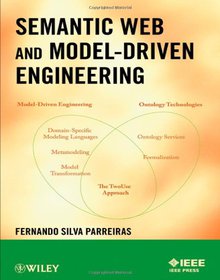Semantic Web and Model-Driven Engineering

Book Details:
| Publisher: | Wiley-IEEE Press |
| Series: | Wiley |
| Author: | Fernando S. Parreiras |
| Edition: | 1 |
| ISBN-10: | 1118004175 |
| ISBN-13: | 9781118004173 |
| Pages: | 264 |
| Published: | Jun 05 2012 |
| Posted: | Nov 19 2014 |
| Language: | English |
| Book format: | |
| Book size: | 6.45 MB |
Book Description:
The next enterprise computing era will rely on the synergy between both technologies: semantic web and model-driven software development (MDSD). The semantic web organizes system knowledge in conceptual domains according to its meaning. It addresses various enterprise computing needs by identifying, abstracting and rationalizing commonalities, and checking for inconsistencies across system specifications. On the other side, model-driven software development is closing the gap among business requirements, designs and executables by using domain-specific languages with custom-built syntax and semantics. It focuses on using modeling languages as programming languages.Among many areas of application, we highlight the area of configuration management. Consider the example of a telecommunication company, where managing the multiple configurations of network devices (routers, hubs, modems, etc.) is crucial. Enterprise systems identify and document the functional and physical characteristics of network devices, and control changes to those characteristics. Applying the integration of semantic web and model-driven software development allows for(1) explicitly specifying configurations of network devices with tailor-made languages,(2) for checking the consistency of these specifications(3) for defining a vocabulary to share device specifications across enterprise systems. By managing configurations with consistent and explicit concepts, we reduce cost and risk, and enhance agility in response to new requirements in the telecommunication area.This book examines the synergy between semantic web and model-driven software development. It brings together advances from disciplines like ontologies, description logics, domain-specific modeling, model transformation and ontology engineering to take enterprise computing to the next level.
Download Link:
Related Books:
Introduction to the Semantic Web and Semantic Web Services
Even though the semantic Web is a relatively new and dynamic area of research, a whole suite of components, standards, and tools have already been developed around it. Using a concrete approach, Introduction to the Semantic Web and Semantic Web Services builds a firm foundation in the concept of the semantic Web, its principal technologies, its real-world applications, and its relevant coding examples.This introductory yet comprehensive book covers every facet of this exciting technology. After an introduction to the semantic Web concept, it discusses its major technical enablers and the relationships among these components. The author then presents several applications of the semantic Web, including Swoogle, FOAF, and a detailed design of a semantic...
Ontology Management
Semantic Web, Semantic Web Services, and Business Applications
Ontology Managememt provides an up-to-date, scientifically correct, concise and easy-to-read reference on this topic. The book includes relevant tasks, practical and theoretical challenges, limitations and methodologies, plus available tooling support. The editors discuss integrating the conceptual and technical dimensions with a business view on using ontologies, stressing the cost dimension of ontology engineering and offering guidance on how to derive ontologies semi-automatically from existing standards and specifications....
MDA Explained
The Model Driven Architecture Practice and Promise
"Jos Warmer's work has contributed greatly to the semantics of the UML. From that perspective, and in this book, he offers insight on how one can and can't use the UML to move to the next level of abstraction in building systems." -Grady Booch Experienced application developers often invest more time in building models than they do in actually writing code. Why? Well-constructed models make it easier to deliver large, complex enterprise systems on time and within budget. Now, a new framework advanced by the Object Management Group (OMG) allows developers to build systems according to their core business logic and data-independently of any particular hardware, operating system, or middleware. Model Driven Architecture (MDA) is a framework ba...
2007 - 2021 © eBooks-IT.org



